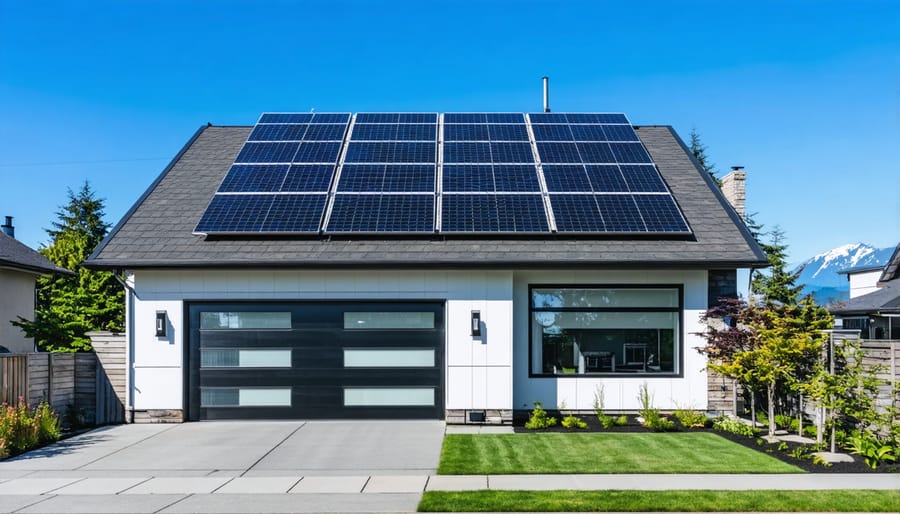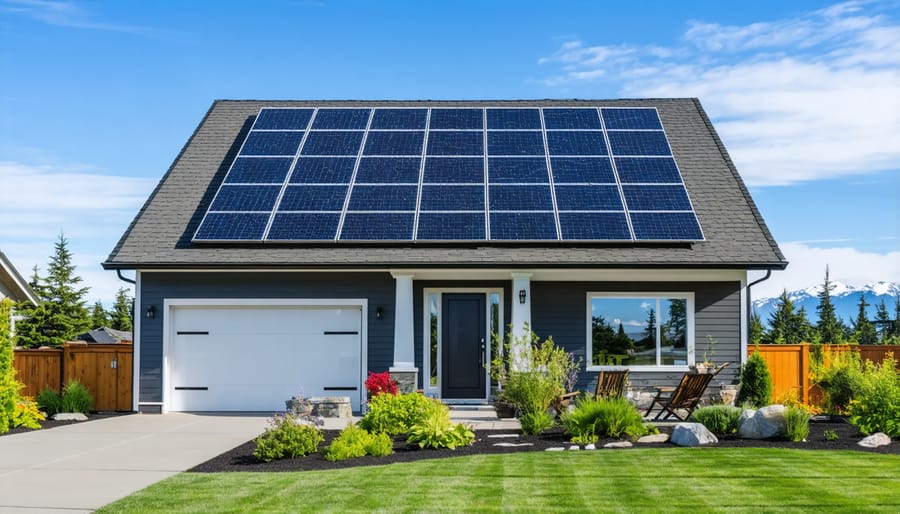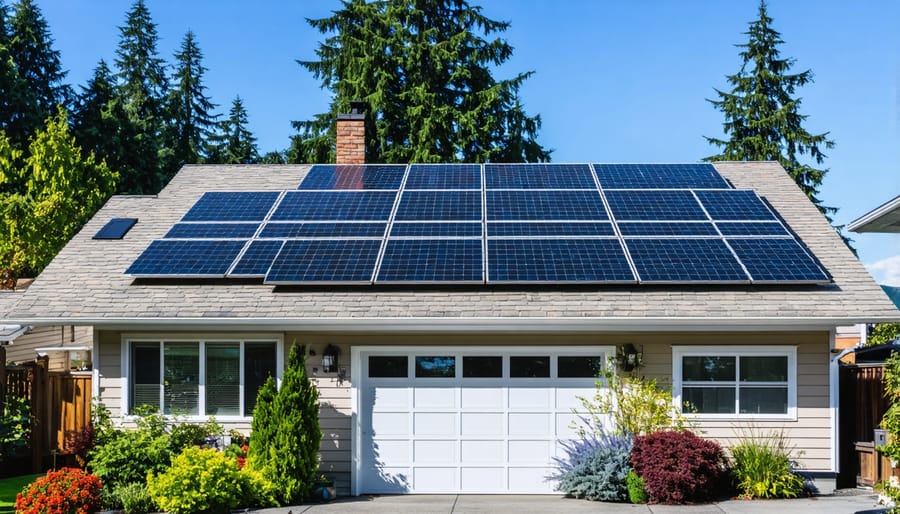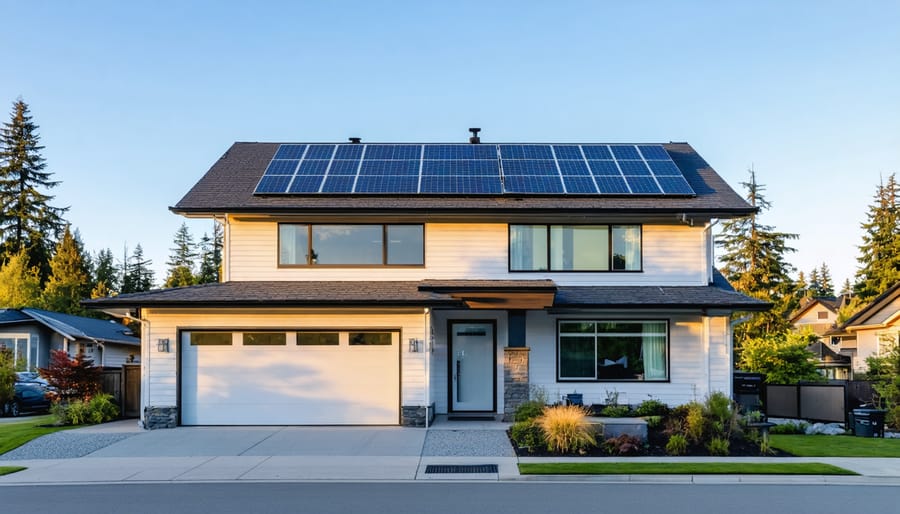**Explore three proven pathways to power your BC home with solar energy without draining your savings.** Solar loans let you own your system immediately while spreading payments over 10-20 years, building equity from day one as your panels generate credits on your BC Hydro bill. Solar leases and power purchase agreements (PPAs) eliminate upfront costs entirely—a third party owns the equipment while you pay only for the electricity produced, typically at rates lower than grid power. Cash purchases, while requiring $15,000-$30,000 upfront for an average BC home, deliver the fastest return on investment and maximize available federal and provincial rebates.
The right choice depends on your financial situation, home equity, and long-term plans. Homeowners planning to stay 10+ years typically benefit most from loans or cash purchases, capturing the full 25-year lifespan value of their solar investment. Those with shorter timelines or limited upfront capital find leases attractive for immediate savings without ownership responsibilities. BC’s net metering program and federal grants up to $5,000 make all three options more accessible than ever, with many Vancouver Island and Lower Mainland families now generating 80-100% of their electricity needs while reducing their carbon footprint by 3-4 tonnes annually.
Why Financing Makes Solar Accessible for BC Homeowners
Installing solar panels on your BC home typically costs between $15,000 and $30,000 depending on your energy needs and roof specifications. For most families, setting aside that amount of cash simply isn’t realistic—especially when juggling mortgages, childcare costs, and everyday expenses.
Here’s the good news: you don’t need a large savings account to go solar. Financing options have transformed solar energy from an exclusive investment into an accessible home upgrade that actually reduces your monthly expenses while you pay it off.
Consider the Anderson family in Kelowna. They were spending $180 monthly on electricity and couldn’t afford $22,000 upfront for solar panels. Through financing, they secured a system with monthly payments of $165—less than their old power bill. From day one, they were saving money while building equity in their home with a valuable solar installation.
This is the reality for many BC homeowners. With Solar Financing 101 options like solar loans, leases, and power purchase agreements, you can start generating clean energy immediately without depleting your savings. The system begins offsetting your BC Hydro costs right away, and in many cases, your combined solar payment plus reduced electricity bill is lower than what you’re currently paying.
BC’s generous solar incentives and net metering program further improve the economics. When your panels produce excess energy during sunny days, you receive credits that offset evening usage—maximizing your savings potential.
Financing essentially allows your future energy savings to fund your solar investment today, making environmental responsibility and financial prudence work hand-in-hand for BC families ready to embrace renewable energy.

Solar Loans: Own Your System from Day One
Secured vs. Unsecured Solar Loans
When exploring solar financing in BC, you’ll encounter two main loan categories: secured and unsecured options, each with distinct advantages depending on your financial situation.
**Secured loans** use your home as collateral and include home equity loans and Home Equity Lines of Credit (HELOCs). These typically offer lower interest rates—often between 5-7%—because the lender’s risk is reduced. You can potentially borrow larger amounts, and the interest may be tax-deductible in some cases. However, you’re putting your home on the line, and approval requires sufficient home equity and a strong credit profile. The Johnsons in Kelowna used their HELOC to finance a $25,000 solar installation, securing a 5.5% rate that reduced their monthly costs significantly.
**Unsecured personal loans** don’t require collateral, making them faster to obtain and less risky for homeowners without substantial equity. Many BC credit unions offer specialized solar loans with competitive rates. The downside? Interest rates typically range from 7-12%, and loan amounts may be smaller. You’ll also need good credit to qualify for favorable terms.
**Which is right for you?** If you have significant home equity and want the lowest interest rate for a larger system, secured loans make sense. For smaller installations or if you prefer not to leverage your home, unsecured options provide flexibility and speed. Consider your equity position, comfort with collateral, and the total system cost when deciding. Most BC solar installers can connect you with financing specialists familiar with both approaches.
What BC Banks and Credit Unions Offer
Several BC financial institutions have recognized the growing demand for clean energy and now offer dedicated solar financing options to homeowners. Coast Capital Savings Credit Union provides green home improvement loans with competitive rates for solar installations, while Vancity Credit Union offers sustainability-focused lending programs that include reduced interest rates for energy-efficient upgrades.
Major banks like TD Canada Trust and RBC have also entered the space with unsecured lines of credit specifically marketed toward renewable energy projects. These typically range from $10,000 to $100,000 with terms up to 10 years.
For example, the Thompson family in Kelowna secured a 6.5% interest rate through their local credit union, saving approximately $2,400 in interest compared to standard personal loan rates. Many BC lenders will also consider the anticipated energy savings in your debt-service calculations, potentially improving your approval odds.
Before applying, compare at least three lenders and ask specifically about their solar or green energy programs—these specialized products often come with perks like waived application fees or cashback incentives that aren’t advertised widely.
Power Purchase Agreements (PPAs): Pay as You Go
Power Purchase Agreements (PPAs) offer a unique “pay as you go” approach to solar energy that removes upfront costs entirely. With a PPA, a third-party company installs, owns, and maintains the solar system on your roof at no cost to you. Instead of buying the equipment, you simply purchase the electricity it generates at a predetermined rate—typically 10-30% lower than BC Hydro’s standard rates.
Here’s how it works: The solar company handles everything from installation to maintenance, while you agree to buy the power produced by the panels for a set period, usually 20-25 years. Your only commitment is purchasing the electricity at the agreed-upon rate, which often includes small annual increases but remains competitive with utility rates.
**Availability in BC**
Currently, PPAs face regulatory limitations in British Columbia. BC Hydro’s net metering program and provincial energy policies make traditional PPAs less common here than in other provinces. However, some solar providers offer similar arrangements or modified agreements that comply with local regulations. It’s worth consulting with BC-based solar installers about what alternatives might be available in your area.
**Who Benefits Most from PPAs**
PPAs work best for homeowners who want immediate electricity savings without capital investment, those who may not qualify for traditional loans, or property owners who can’t claim tax incentives. They’re particularly appealing if you prefer a hands-off approach—the third party handles all maintenance and repairs.
Consider the Richmond family who explored a PPA-style agreement: they redirected their monthly savings into other home efficiency upgrades, creating a comprehensive sustainability approach without touching their savings.
**Important Considerations**
Before committing, understand that selling your home requires transferring the PPA to the new owner or buying out the agreement. Additionally, while you save on electricity, you won’t own the system or benefit from increased property value. Calculate your long-term costs carefully—sometimes PPAs cost more over 25 years than purchasing outright, despite the convenience.
Solar Leases: Low Upfront Costs with Predictable Payments
Solar leasing offers BC homeowners a straightforward path to clean energy without the substantial upfront investment required for purchasing a system. Unlike Power Purchase Agreements where you pay for the electricity generated, a solar lease involves fixed monthly payments for using the solar equipment installed on your roof—similar to leasing a car.
With a typical solar lease, you’ll pay a predictable monthly amount (usually between $50-150 depending on system size) for the duration of your contract, typically 20-25 years. This payment remains consistent throughout the term, making budgeting simple. The amount is often comparable to or lower than what you’d save on your BC Hydro bill, meaning you can start benefiting from solar with little to no additional monthly expense.
One significant advantage is that the leasing company maintains ownership and responsibility for system maintenance, repairs, and monitoring. If your inverter fails or panels need servicing, you simply contact the provider—no unexpected repair bills. This peace of mind appeals to homeowners who want hassle-free solar energy.
However, BC homeowners should consider several factors before committing to a lease. Since you don’t own the system, you won’t qualify for certain government incentives that system owners receive. The lease also transfers to new owners if you sell your property, which requires buyer approval and can sometimes complicate real estate transactions. In Victoria, the Thompson family discovered this when selling their home—though buyers ultimately appreciated the lower energy costs, the lease transfer process extended their closing timeline by two weeks.
Additionally, at the end of your lease term, you’ll typically have options to purchase the system at fair market value, extend the lease, or have it removed. Understanding these end-of-term scenarios upfront ensures no surprises down the road.
Government Incentives and Rebates That Reduce Your Costs
BC’s Clean Energy Rebates and Programs
British Columbia homeowners have access to several financial incentives that can significantly reduce the cost of going solar. The federal Canada Greener Homes Grant provides up to $5,000 for qualifying solar installations, while BC Hydro periodically offers net metering programs allowing you to receive credits for excess electricity your system generates and feeds back to the grid.
Many BC municipalities have introduced property tax exemptions for solar installations, meaning the added home value from your solar system won’t increase your property taxes. For example, Vancouver and Victoria have implemented these exemptions, making solar investment more attractive. Some regional districts also offer additional rebates through their climate action programs.
It’s worth exploring BC solar rebates early in your planning process, as programs can have funding caps and application deadlines. Local credit unions across BC frequently provide green energy loans with preferential rates for solar projects, recognizing the long-term value and environmental benefits.
Take Action: Check your municipality’s website for local solar incentives and contact BC Hydro about net metering eligibility. These programs stack with financing options, maximizing your savings potential.
Federal Programs Every BC Homeowner Should Know
The federal government offers several programs to make solar more affordable for BC homeowners. The Canada Greener Homes Grant provides up to $5,000 toward solar installations, plus additional funding for home energy evaluations. This grant has already helped thousands of Canadian families transition to clean energy without breaking the bank.
Beyond the Greener Homes initiative, homeowners can access interest-free loans through the Canada Greener Homes Loan program, offering up to $40,000 to cover installation costs. These funds can be combined with provincial incentives and utility rebates to significantly reduce your out-of-pocket expenses.
Take the Richardson family in Kelowna, who combined federal grants with BC Hydro rebates to cover nearly 40% of their solar system costs. Their monthly savings on electricity now exceed their loan payments, effectively making their transition cash-flow positive from day one.
To maximize your savings, start by booking a home energy evaluation to identify your eligibility. The assessment fee is typically reimbursed through the grant program, making it a risk-free first step toward affordable solar energy.

Choosing the Right Financing Option for Your Situation
Selecting the right solar financing option depends on your unique financial situation and energy goals. Here’s a practical framework to guide your decision.
**Start with Your Credit Score**
Your credit score significantly impacts which options are available and their terms. If you have excellent credit (above 700), you’ll qualify for the best loan rates and can consider all financing paths. Those with lower credit scores might find lease or PPA agreements more accessible, as these typically have less stringent requirements.
**Evaluate Your Home Equity**
Homeowners with substantial equity can leverage it through home equity loans or lines of credit, often securing lower interest rates than solar-specific loans. However, only pursue this route if you’re comfortable using your home as collateral. If you have limited equity or prefer not to tap into it, solar loans or lease agreements offer viable alternatives without affecting your home equity.
**Consider Your Timeline**
Planning to stay in your home for at least 10-15 years? Purchasing through cash or loans maximizes long-term savings and allows you to benefit from the full solar payback period. The Vancouver Island family we mentioned earlier planned to age in place, making their solar loan an ideal choice. If you might move within five years, a lease or PPA transfers easily to new homeowners and requires minimal upfront commitment.
**Assess Your Monthly Budget**
Be realistic about monthly payments. Solar loans and leases spread costs over time, but ensure payments fit comfortably within your budget. Remember that most financing options reduce or eliminate your electricity bill, so your net monthly expense often decreases despite the new payment.
**Clarify Your Energy Goals**
Are you aiming for maximum savings, environmental impact, or energy independence? Cash purchases and loans offer the greatest long-term financial returns and full system ownership. Leases and PPAs prioritize immediate savings without ownership responsibilities, perfect if you value simplicity over maximum returns.
**Take Action**
Request quotes from multiple BC solar installers, comparing not just system costs but financing terms. Use online solar savings calculators to model different scenarios with your actual energy consumption. Most importantly, don’t let perfect be the enemy of good—the best financing option is the one that gets solar panels on your roof and starts generating clean energy today.

Real BC Homeowners Share Their Financing Stories
Sarah Chen never imagined she could afford solar panels on her East Vancouver townhouse. As a first-time homeowner working as a teacher, the $18,000 upfront cost seemed impossible. “I looked into a solar loan through a local credit union,” she explains. “With BC’s provincial tax credit and my utility company’s rebate, my monthly loan payment is actually less than what I was paying in electricity bills before.” Two years in, Sarah’s energy costs have dropped by 75%, and she’s on track to fully own her system in seven years.
Meanwhile, the Patel family in Kelowna took a different approach. With equity built up in their rural property, they opted for a HELOC to finance their 10-kilowatt system. “The interest rate was lower than a solar-specific loan, and we liked having the flexibility,” says Raj Patel. Their larger system generates enough power year-round to cover their home and workshop. “In the sunny Okanagan, our panels produce even more than expected. We’re actually selling excess power back to the grid.”
For Mike and Jennifer Thompson in Prince George, a solar lease made the most sense. “We’re not sure how long we’ll stay in this house,” Mike admits. “The lease meant zero down payment, and we started saving money immediately on our bills.” Their northern location presents unique challenges, but the lease agreement included performance guarantees. “Winter production is lower, obviously, but summer makes up for it,” Jennifer notes. “We’re thrilled we didn’t let our location stop us from going solar.”
Each family’s situation was different, but they all found a financing path that worked for their circumstances—proving that solar energy is accessible regardless of where you live in BC or what stage of homeownership you’re in.
Questions to Ask Your Solar Installer About Financing
Before signing any solar agreement, asking the right questions can save you thousands and prevent future headaches. Start by inquiring about financing partnerships: “Which lenders do you work with, and do you receive commissions from them?” Understanding this relationship helps you assess whether recommendations truly serve your interests.
Dig into the details of payment structures by asking, “What’s included in the total project cost, and are there any additional fees?” Request an itemized breakdown covering panels, installation, permits, and post-installation services. Some installers in Vancouver have learned to ask specifically about interconnection fees and any charges for monitoring systems.
Contract terms deserve careful scrutiny. Essential questions include: “What happens if I sell my home?” and “Can I prepay without penalties?” For lease or PPA agreements, ask about escalation clauses—annual payment increases that some BC homeowners overlook until year two.
Don’t forget to explore all available incentives: “Will you help me access federal and provincial rebates?” A quality installer should guide you through programs like the Canada Greener Homes Grant and explain how these reduce your net cost.
Finally, ask about warranties and maintenance: “What’s covered under warranty, and for how long?” Understanding who handles repairs—especially for financed systems—protects your investment for decades.
Take notes during these conversations and compare responses from multiple installers. The transparency and patience they demonstrate during this process often reflects the service you’ll receive throughout your solar journey.
Making the switch to solar energy is more financially accessible than ever, with multiple pathways designed to fit different budgets and goals. Whether you prefer owning your system outright through cash purchase or loan, or starting with zero upfront costs through a PPA or lease, there’s an option that aligns with your financial situation. BC homeowners are already experiencing the benefits—lower electricity bills, increased home values, and reduced environmental impact—while accessing provincial and federal incentives that make solar more affordable.
Your next step is simple: calculate your potential savings using an online solar calculator to see real numbers based on your home’s energy use and roof specifications. These tools provide personalized estimates within minutes, helping you understand your return on investment.
Ready to explore which financing option works best for you? Connect with certified BC solar installers who can assess your property, explain available incentives, and provide tailored financing consultations at no obligation. They’ll walk you through the numbers, answer your questions, and help you design a solar solution that makes both environmental and financial sense for your household. The path to clean, affordable energy starts with a conversation.

